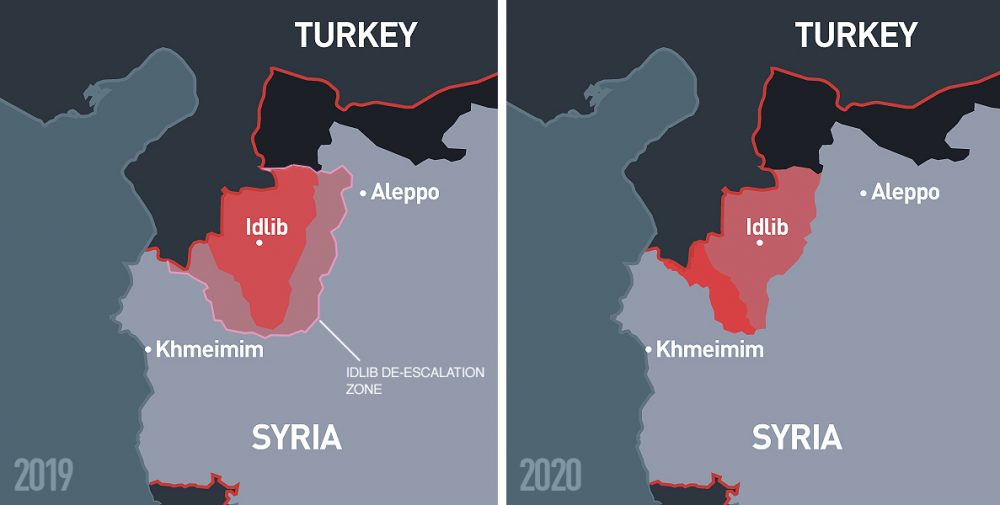Turkey & Syria on brink of WAR in Idlib: How did it come to this? Latest situation reports & analysis
NONE of this would be happening if the US had not created ISIS (and continued to support to this day) the treacherous, horrid mess that is consuming the Middle East.
A dispatch from RT.com
The Idlib governorate, located in the northwestern part of Syria on the border with Turkey, is the last major stronghold of armed groups that have been fighting to topple the government of Syrian President Bashar Assad for the past several years. The region was spared a Syrian Army offensive in 2018 on a request from Turkey, which said it didn’t want to face a new influx of refugees from Syria after already taking in some 3.6 million people.
Who is fighting who
Many of the fighters in Idlib came from elsewhere. Some are foreign mercenaries, who arrived in Syria to join various jihadi groups funded by countries like Qatar and Saudi Arabia and didn’t leave the country after Russian military intervention turned the tide of battle in favor of Damascus. Others are Syrians, who were part of anti-government forces in liberated hotspots like Aleppo or Douma, and were granted safe passage to Idlib.
Also on rt.com Even NATO is unwilling to touch Turkey’s Idlib mess with a ten-foot pole
Turkey, which was among the supporters of anti-Assad fighters, has a sway among some of the armed groups in Idlib. Others, like Hayat Tahrir al-Sham (HTS) — the major Syrian jihadist faction formerly pledging allegiance to Al Qaeda — are considered terrorists by Ankara. In reality, the extremists occasionally fight alongside the Turkey-backed groups against the approaching Syria armed forces and their allies.
What ceasefire deal said
The September 2018 deal between Turkey and Russia established a path towards de-escalation of violence in Idlib. A demilitarized zone (DMZ) within the militant-held area was agreed, and terrorist groups including HTS were to leave this buffer zone entirely, while the so-called “moderate” rebels only had to pull back heavy weaponry.
Damascus agreed to stop the offensive, while Ankara was supposed to use its influence in the Syrian province to convince more independent groups to observe a ceasefire, and eventually bring a lasting cessation of hostilities.
A chain of observation posts was established by Turkey to monitor the situation on the ground. Groups rejecting the plan and perpetrating violence would remain a legitimate target for the Syrian military.
But the agreement has never fully worked as intended, with both parties accusing each other of constant violations. Russia was also unhappy with how things worked out, since militants in Idlib have been launching regular drone attacks against the Russian air base in Latakia.
What happened in reality
Worse still, instead of pulling back, the jihadist faction actually went on offensive in Idlib, with HTS gaining dominance and capturing much of the province. With no end of terrorist raids in sight, the Syrian Army resumed the offensive in April 2019, and started taking villages and towns in southern Idlib.
In addition to security consideration there was a strategic one. Saraqib, the city east of provincial capital Idlib, which saw some intense fighting this month, sits on a highway connecting Aleppo in the north with Hama, Homs and Damascus in southern Syria.
The advances of the Syrian Army unnerved Ankara, since it changed the balance of power in the area and opened a possibility for a surprise offensive against Idlib, an outcome that the agreement with Russia was supposed to prevent. It also brought Turkish and Syrian troops within close proximity, leading to increased risk of direct clashes.
Turkey had its first significant loss of troops to Syrian fire in Idlib in August last year, after one of its convoys was hit by a Syrian airstrike. Damascus had, in turn, claimed the Turks were supplying jihadists with weapons and ammunition. More similar incidents followed, with the latest and most serious coming on Thursday, in which thirty three Turkish soldiers have been confirmed killed and dozens of other injured. Turkey has so far responded by firing at the Syrian Army positions in Idlib.
Moscow said the Russian Air Force did not take part in the deadly raid, but suggested that the losses could have been much worse if it didn’t intervene to stop the Syrian sorties. The Russian military added that the strike was meant to prevent an HTS offensive, and that the Turkish forces were not supposed to be there according to Ankara’s own memo.
What dangers escalation holds
The Thursday disaster marks only the latest Turkish casualties in Syria. Ankara conducted several military operations over the past several years, with dozens of its soldiers killed, according to official data. But while the Turkish troops had previously fought only Kurdish militia and Islamic State — at least openly — the deadly strike has directly pitted Ankara forces against those of Damascus.
Turkish President Recep Tayyip Erdogan demanded that Damascus pulled back all its troops out of Idlib by end of February, saying that otherwise he will sent the Turkish army to force them out. Turkish officials are saying the Syrian forces will now be designated as legitimate targets. But Syria doesn’t appear to be caving it to the ultimatums, even as Turkey-backed militants are fiercely fighting against government forces in Idlib.
The conflict also seriously strains Turkey’s relations with Russia, which are dangerously heading to their new lowest point since the crisis of 2015, prompted by the downing of a Russian warplane by a Turkish fighter jet on Syrian-Turkish border. Several rounds of talks between the two nations have so far failed to resolve the situation, which seems to be growing more volatile by the hour.
The threat of a Russia-Turkey-NATO hot war over Idlib is a godsend for US foreign policy
[dropcap]T[/dropcap]urkey is calling for NATO’s protection after 33 of its soldiers were killed in an apparent Syrian airstrike in Idlib, allegedly while fighting in terrorist ranks. In the regional chaos that ensues, only one player stands to gain.
Speculation over what’s to come next has seen #article 5 trending on Twitter in the hours following the attacks, after Omer Celik, spokesman for Turkey’s ruling AKP party, indicated to reporters in Ankara that he was looking at requesting formal NATO protection against Damascus and, by proxy, the Russian air force.
“We call on NATO to [start] consultations. This is not [an attack] on Turkey only, it is an attack on the international community. A common reaction is needed. The attack was also against NATO,” Celik told Turkish media.
Article 5 of the NATO treaty says an attack on one member is an attack on them all.
The US State Department also condemned the attack, stating that it stands by its “NATO ally Turkey.” It further stated that it continues to “call for an immediate end to this despicable offensive by the Assad regime, Russia and Iranian-backed forces.” Never one to let us down, the US envoy to NATO Kay Bailey Hutchinson also told journalists that “everything is on the table.”
However, it is unclear if NATO has the stamina to back Turkey in any meaningful way in a war against a Syrian government which is backed by Russian air power. It is also unclear if Article 5 extends to NATO allies when they have effectively invaded a foreign entity. In fact, even if no corporate media entity would willingly admit it, the nation defending itself in this specific set of facts is Syria – not Turkey.
That being said, Ankara has found a way to ensure that European nations do not flat-out ignore the situation. Just recently, Turkey reportedly opened up the Idlib border to allow an influx of Syrian refugees to flee to Europe, which will surely magnify regional tensions to a significant extent.
Moscow has responded to the situation by highlighting Ankara’s relationship with the various jihadist entities in Syria. According to Russia’s Defense Ministry, the airstrike was carried out when the Syrian Army was repelling an offensive by Syria’s official al-Qaeda offshoot, Hayat Tahrir al-Sham, inside the Idlib “de-escalation zone.” Of course, anyone who has been paying attention to the war in Syria can appreciate that Ankara’s material and financial support for terrorist groups in Syria, including and especially Islamic State (IS, formerly ISIS/ISIL), has long been documented.
Whether a hot war is on the table or not, the current situation is almost ripe for the United States foreign policy establishment, which has been dreaming of putting Russia and Turkey on a collision course for a while now. If you doubt this, you need only look to this final paragraph of a recent Guardian article:
“Kay Bailey Hutchison, the US ambassador to Nato, said Thursday’s events should show Turkey “who is their reliable partner and who isn’t” and prompt it to drop its purchase of a major Russian missile defence system, which Washington says threatens the western alliance.” [emphasis added]
The US has been seriously troubled by Turkey’s move to procure Russia’s S-400 missile system. Washington is also concerned by Turkey’s desire to join the China-Russia dominated Shanghai Co-operation Organisation (SCO), which could see Turkey in an alliance with not only Russia and China, but Iran as well.
The US is willing to back Turkey into a corner in which it finds itself confronting Russia, with or without the full support of the NATO alliance, if it means that what was looking like a budding fruitful relationship between Ankara and Moscow will fall completely apart.
On the other hand, Moscow, a key ally of the Syrian government, is unlikely to stand by while Turkey insists on invading Syrian territory and defending the various jihadist groups which have wreaked havoc in Syria for close to a decade.
Perhaps this is what Donald Trump was hinting at when he recently said he would pass the fight against IS over to Iraq, Syria, Iran and Russia while he focused on maintaining control of oil and resources. The US can sit on the sidelines and watch other nations fight among themselves, while the US concentrates on the spoils of war.
The divide-and-conquer strategy of the American empire is still alive and well. Given the risk of a heightened conflict involving a NATO member who holds a significant stock of US nukes, one can only hope that cooler heads will prevail and avert the ignition of such a regional powder keg.

• remember: ALL CAPTIONS, IMAGES, PULL QUOTES AND ANNOTATIONS BY THE EDITORS, NOT THE AUTHOR—
[premium_newsticker id="211406"]
Read it in your language • Lealo en su idioma • Lisez-le dans votre langue • Lies es in Deiner Sprache • Прочитайте это на вашем языке • 用你的语言阅读
[google-translator]

THIS WORK IS LICENSED UNDER A Creative Commons Attribution-NonCommercial 4.0 International License
OF INTEREST TO OUR READERS
Acclaimed by critics, Ron Ridenour’s incisive history of the struggle between the US and Russia, extending from the Bolshevik revolution to our day, plus a wide-ranging and comprehensive analysis of many cultural America features which continue to bolster the US drive for world domination, is now available in print at a discount price. It’s 564 pages packed with information, many critical but practically unknown facts, and an uncompromising revolutionary perspective on the colossal challenges confronting this generation. (Click here or on the image below to order.)
 |
|







